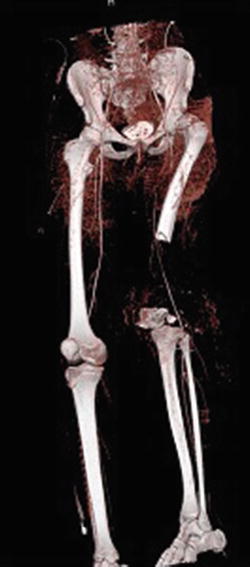Fig. 1
Clinical picture of the bone defect

Fig. 2
Three-dimensional CT reconstruction of the leg. Contrast agent was utilized for detecting a vascular injury
3 Preoperative Problem List
1.
Polytraumatized patient
2.
Left hip dislocation
3.
Type 3 open femoral fracture (subtotal amputation)
4.
Massive bone defect with absent patellar tendon
5.
Vascular injury (femoral vein laceration)
6.
Contaminated soft tissue
4 Treatment Strategy
(a)
Closed reduction of the hip dislocation.
(b)
Mounting of a joint-bridging external fixator.
(c)
Vascular repair of the femoral vein.
(d)
Fasciotomy of the upper and lower leg and temporary coverage with synthetic skin.
(e)
Custom-made spacer with bone cement and K-wires was placed into the bone gap (07/2010).
During the following weeks,
The leg length discrepancy was treated by:
In the last step,
(f)
Several revision surgeries and changing of the Vacuum assisted closure (VAC) was performed until
(g)
Split-skin graft covered the soft tissue defect (08/2010).
(h)
Mounting a monotube on the femur
(i)
A multiplanar ring fixator on the tibia. Osteotomies were performed just below the lesser trochanter and below the tibial plateau.
(j)
A Hoffman fixator was added to connect the two frames in the knee region (09/2010).
(k)
An arthrodesis nail was inserted after frame removal to reduce the consolidation time in the frame and to realign all fragments (05/2011).
5 Basic Principles
1.
Anatomic joint reconstruction in cases of severe or destroyed articular fractures is usually not possible in the initial damage control surgery. In these cases a joint-bridging external fixator is useful to protect the soft tissue, to stabilize the joint when severe ligament injury is present, or when a vascular repair has been performed.
2.
Vessel injuries commonly occur in multiple-injured patients especially in the lower extremity. Direct injuries are caused by sharp and stump violence, indirect mechanisms by tension, distraction, or torsion. The diagnosis or suspicion of a vascular injury begins with the clinical investigation. Hard signs include active hemorrhage, large expanding or pulsatile hematoma, absent palpable pulses distally, and distal ischemia.
3.
Early surgical soft tissue debridement




Stay updated, free articles. Join our Telegram channel

Full access? Get Clinical Tree








